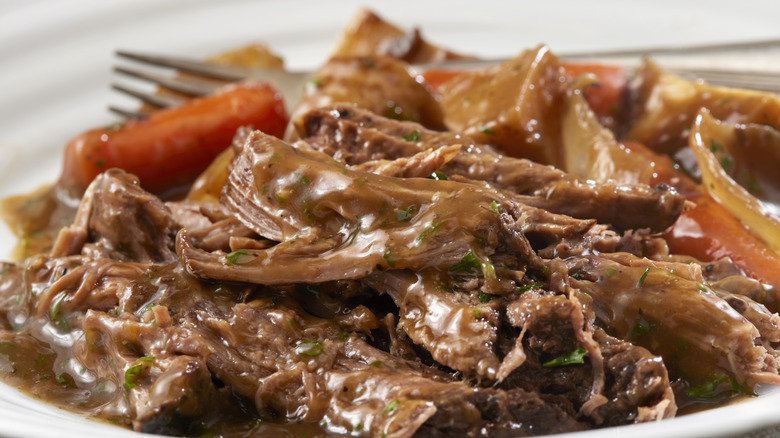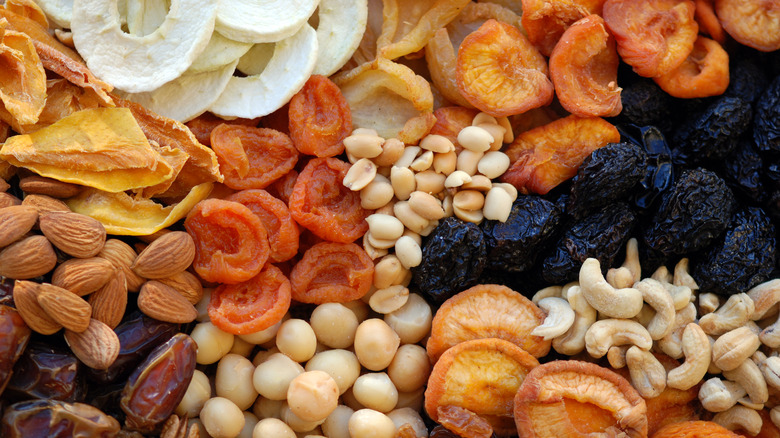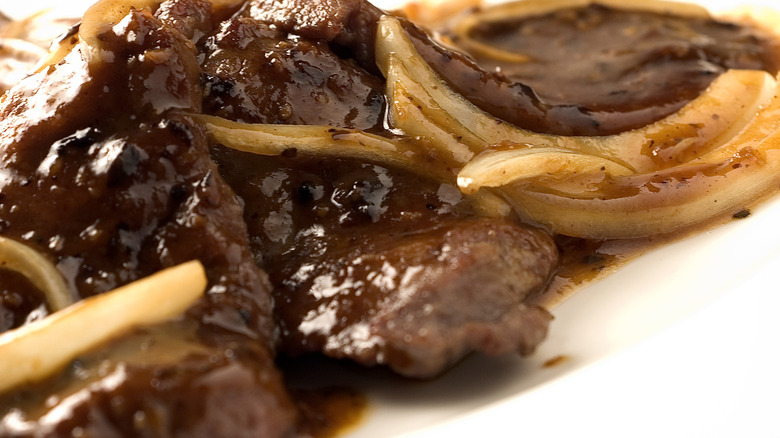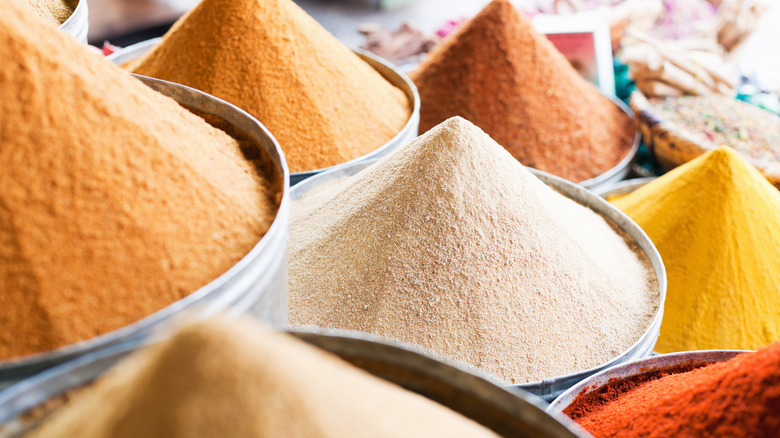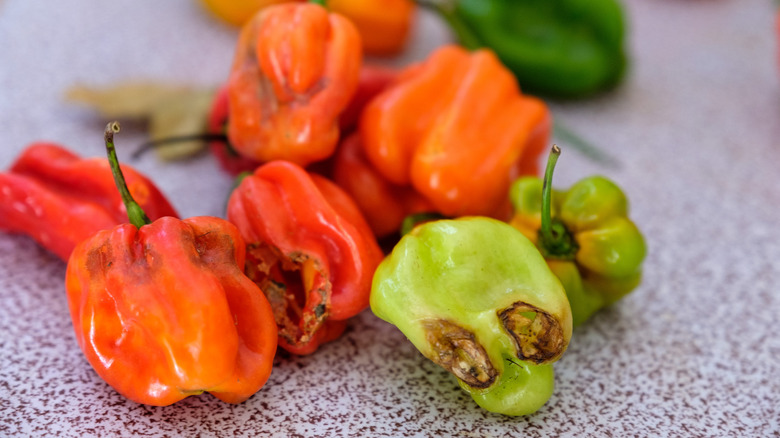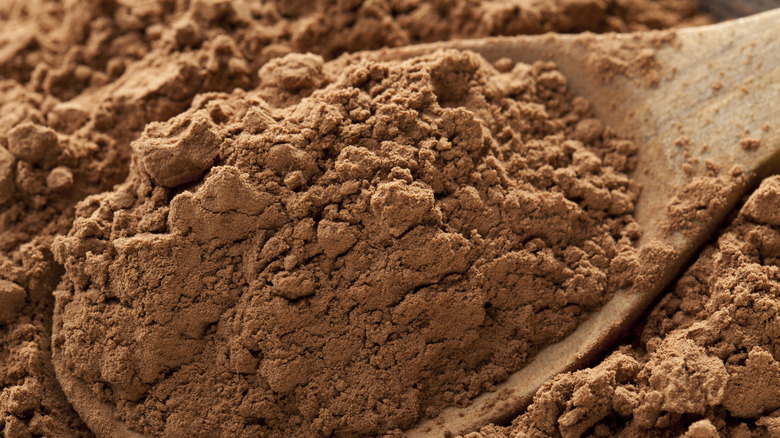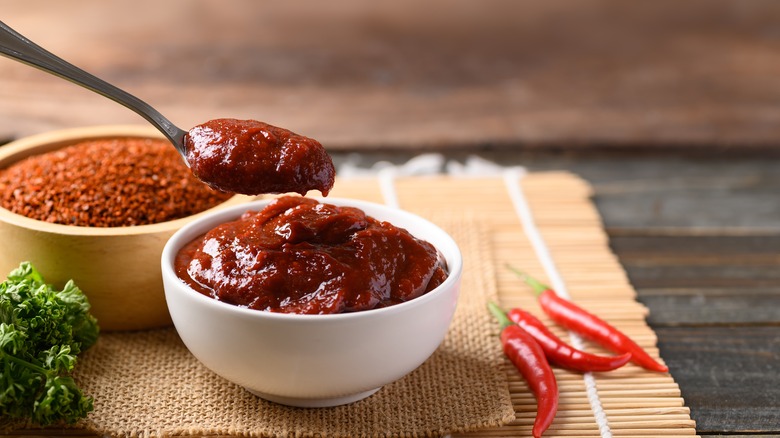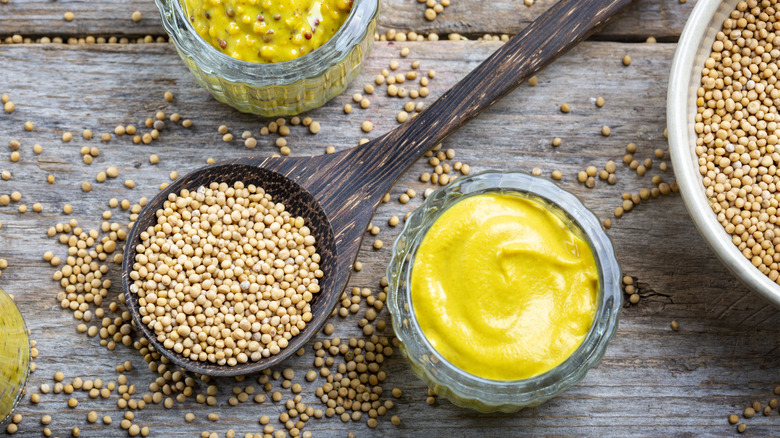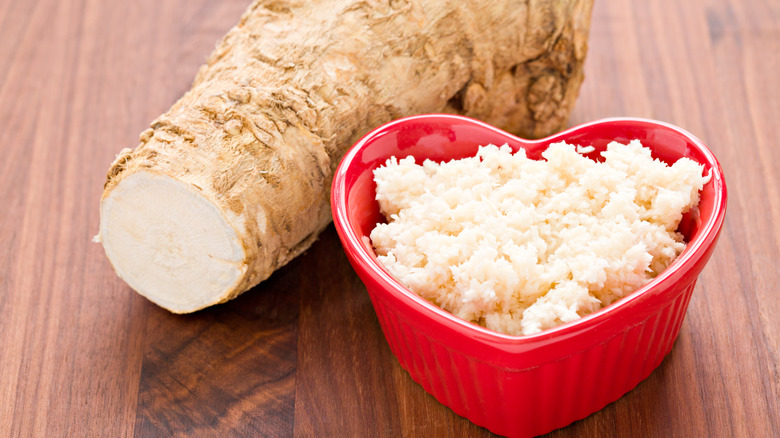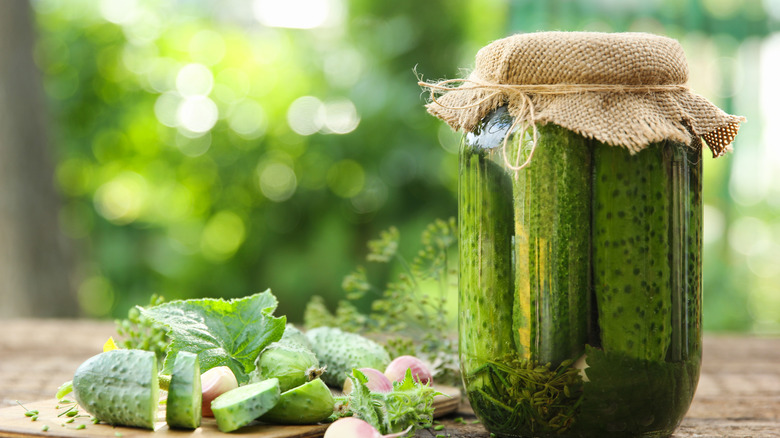Bold Ingredients That Will Upgrade Your Pot Roast
On a cold evening when you're hungry and craving something comforting, nothing is more welcoming than a big platter of pot roast. Everything about it signals comfort: Because it involves such large cuts of meat, it's meant to be shared with friends and family, so it comes with companionship as well as nourishment. And it's a fairly forgiving dish to make: If your meat is sloppily tied or vegetables unevenly cut, it's all good — thus, almost anyone can treat those they love to a pot roast feast. The only real talent needed to make pot roast is patience. It requires a long, slow braise, so making it needs to be an intentional act. This could be why a dish of pot roast feels so nurturing.
But even the most beloved comfort foods can get old after a while. The familiarity of your grandmother's pot roast recipe may be part of its appeal, but there might be times when you want to offer your friends that same comforting vibe ... with a fresh twist. Luckily, the meat cuts that make the best pot roast, such as brisket and chuck roast, are affordable and loaded with hearty, beefy flavor that plays well with a wide range of bold flavorings. So if you're looking for simple ways to transform your pot roast from soothing to spectacular, look no further.
Dried fruit
When most of us envision pot roast, we think of a dish napped in a rich, meaty brown gravy or broth, perhaps with some cooked carrots and onions tucked in. It's a beloved classic for good reason, but you might be wondering if it's possible to make a pot roast with a lighter, brighter flavor profile — or one that's not just a sea of brown on your plate. And an ingredient you might have never associated with pot roast – a bag of mixed dried fruit – can help you deliver all this and more.
Believe it or not, dried fruit isn't just for trail mix and baking projects — it can also offer a refreshing pop of sweetness and color to a pot roast. Just place a bag of mixed dried fruit in a slow cooker with a sliced onion and your roast, cover with apple juice, and season with salt, pepper, and allspice. As the meat cooks and softens, so does the fruit, becoming tender as the flavors of the different fruit combine with the liquid to form a complex, savory-sweet sauce.
Coffee
If you're seeking a pot roast that will wake up your taste buds (and perhaps your nervous system), turn to that cup of leftover coffee from breakfast. Mixed with soy sauce and poured over the roast and some sliced onions and garlic, it adds a toasty depth and creates a sauce that looks ordinary but tastes anything but. Don't worry, it won't taste like someone dumped a caramel macchiato over your roast. The flavor profile will be unambiguously savory, with a slightly smoky punch.
While it might seem strange to some, the idea of using coffee in savory sauces is far from new: Red-eye gravy, a classic preparation in the American South, consists simply of old coffee simmered with the drippings left over after pan-frying ham. This super-fast and basic sauce, when traditionally made, isn't even fully emulsified — the name "red eye" refers to the pink patches of ham fat that naturally separate out of the hot coffee mixture. While much beloved in its traditional form, modern Southern cooks have refined it, turning it into a smoother, richer sauce for pastas and other dishes. And with a bit of coffee, you can bring a similar vibe to your pot roast too.
Asian black bean sauce
There's no reason pot roast has to be locked into North American or European cooking traditions. At the end of the day, it's just a big ole piece of meat begging to be embellished with whatever flavors you choose. Obviously, however, you're going to want flavors that complement the naturally savory flavor of beef and are bold enough not to be overwhelmed by them. And some of these flavors come from sources you might not expect.
One surprising option is Asian black bean sauce. No, the black beans are not the ones you find alongside your fajitas, but are instead salted, fermented soybeans (the fermentation process turns the soybeans black). You can find bags of these black beans at Asian markets, but more conveniently, you can also find jars of black bean sauce, in which the beans are ground and combined with other seasonings such as ginger, garlic, and soy sauce. The sauce has a salty, gamy punch that makes it a great partner for pot roast: Just add a generous portion to your meat and veggies before braising, and you won't be sorry.
Beer
Among the many virtues of beer is how wonderfully it pairs with flavored meat dishes. Many people love a cold, frothy beer with a hot dog or burger, and it's no accident that sausages are the meal of choice for attendees of Munich's famed Oktoberfest. And besides being a perfect accompaniment to a meaty meal, beer can also be one of its defining ingredients. The classic Belgian beef stew carbonnade flamande, for example, features beef chunks and vegetables stewed in a sauce featuring dark Trappist ale.
Following this logic, beer can also be a welcome addition to a pot roast. Besides adding flavor, the acids and tannins in beer serve as meat tenderizers, a useful feature when cooking the tough cuts typically used for pot roast. And because beers come in so many varieties with so many flavor profiles — from light, crisp lagers to sweet stouts and more — you can change up your pot roast by changing up your choice of beer. Chocolate stout, along with beef broth and cocoa powder, form a rich sauce with black mole vibes. But for a more classic profile, flavor a savory-sweet sauce with porter or lager, depending on your taste.
Moroccan veggies and spices
The magic of braises such as pot roasts is that when made well, the whole is more than the sum of its parts — a handful of ordinary ingredients come together and are transformed by heat and time into something special. Moroccan cooks have long valued braising as a means of coaxing maximum flavor from food, and Moroccan tagines – slow-cooked stews named for the clay containers they have traditionally been cooked in — are known for their deep and varied flavors and their use of punchy seasonings such as fresh herbs, salt-cured lemons, and warm spices, as well as for their generous and creative use of fruits and vegetables.
If you want to liven up your pot roast — and transform it from a meaty main dish into a meal in one – use Moroccan traditions as your inspiration. Along with the more familiar carrots and onions typically used in pot roast, add cubes of eggplant and canned chickpeas, and flavor the roast with cayenne, a spice mixture containing cumin, coriander, cinnamon, pepper, and cloves, and a touch of honey. Serve with flatbread or couscous if you like — the bright, warming mixture of flavors and textures is sure to satisfy.
Scotch bonnet chiles
Pot roast has a reputation as a warming dish — intended to sooth rather than surprise. If you're looking for a way to add a bit more spark to your pot roast or would like to blend a little something to cut through the fatty richness of the meat, consider making a Jamaican-inspired pot roast liberally flavored with scotch bonnet chiles. In this dish, the scotch bonnets enliven a light, tomato-based sauce, a nice change-up from traditional pot roasts.
A beloved ingredient in West Africa and the West Indies, scotch bonnet chiles provide not just a serious dose of heat (boasting a hotness level up to 300,000 Scoville units, they're among the hottest peppers available), but a distinctive tropical fruit aroma. This means you won't need very many of them (three at most) to punch up a full-sized pot roast. And just as you would when working with any fresh hot pepper, use caution – wear gloves if your fingers are sensitive and be careful not to get any pepper residue in your eyes.
Cocoa powder
Carnivore cooks have long known that chocolate isn't just for dessert. It shows up as a secret (or not-so-secret) ingredients in savory, meat-related dishes ranging from spice rubs for grilling to chili to barbecue sauce. And for many food lovers, the classic sweet-savory Mexican sauce mole negro, or black mole, is their first (and perhaps only) exposure to how chocolate can be put to use as part of a main dish.
So it's no surprise that cocoa powder has also emerged as an under-the-radar flavor booster for pot roast. But just as cocoa-enhanced spice rubs and sauces can have varied flavor profiles, so can cocoa-enhanced pot roasts. In one version, the pot roast is seasoned with a mocha rub that includes ground coffee, chili powder, smoked paprika, and pepper along with the cocoa, then braised with beef broth, more coffee, and dried figs. In another, the cocoa powder augments a sauce of red wine, crushed tomatoes, and chopped chipotles en adobo. In both, you'll get what looks like an ordinary pot roast — but with a distinctively appealing flavor that will grab everyone's attention.
Gochujang, ginger, and soy sauce
For the past few years, Korean food and culture has been in the spotlight as Americans finally discovered the joys of Korean skincare products, started finding Korean pantry staples such as gochujang (red pepper paste) in their supermarkets, and took to binge-watching Korean shows such as "Squid Game." The stateside appeal of Korean food is easy to understand. Many of the flavors commonly used in Korean cooking, such as soy sauce, ginger, and sesame oil, are already familiar to American fans of Chinese and Japanese cuisine. And the sweet-salty flavor profile of Korean barbecued meat — the gateway Korean food experience for many Americans — is easy to like, as is the casual, interactive nature of the whole meal.
Less known to most American diners are Korean braises, in which chunks of meat are slow-cooked in flavorful broths and sauces. If you've tasted any of these and enjoyed them, you'll love making a pot roast inspired by Korean flavors. It uses pretty much the same methodology as any other pot roast: Salt and pepper the roast, brown it in a heavy pan, then slowly braise it in a sauce, which in this case includes sake, mirin, gochujang, garlic, onion, ginger, and broth. Add some carrots and mushrooms near the end of cooking and continue braising until they're tender. As a bonus, the leftovers make a great filling for Korean tacos.
Mustard
A pot roast can be a lot of things, but it's never going to be a light dish – the cuts of meat used for pot roast are loaded with fat and connective tissue, which melt as the meat cooks and are largely responsible for the rich, buttery flavor and velvety mouthfeel we associate with the dish. This unctuousness is part of what makes pot roast is so appealing on a winter evening. But it's also why the dish as a whole can sometimes be a bit too much — sometimes, it can feel overwhelming after just a few bites.
This is why it's a good idea to add a bit of acid or spice to your pot roast to brighten up the flavors and serve as a foil for the richness. And an easy option that most home cooks already have in their refrigerators is mustard. It works well as an addition to pot roast for the same reasons it's long been served alongside meat as a condiment — its heat and tanginess make the dish seem lighter and brighter. A few generous dollops of mustard – a mix of Dijon and grainy mustards is nice for the heat and texture they offer – mixed into a braising liquid of white wine, rosemary, and broth will give you a pot roast that will stick to your ribs without numbing your palate.
Horseradish
Pot roast is so inherently rich it almost begs for an ingredient with some tanginess or bite, such as wine or pepper, to keep the richness from feeling or tasting like greasiness. Mustard is a great flavor booster for pot roast because of the brightness and heat it brings. But if you think your pot roast needs even more punch, turn to an ingredient with even more firepower: horseradish.
A type of lumpy, spicy radish, horseradish is most commonly found as jarred prepared horseradish or as jarred creamy horseradish, which are often served as an accompaniment to meats such as roast beef. (If you're lucky enough to find a fresh horseradish root, you can make your own prepared horseradish or sauce by finely shredding the horseradish, adding a bit of vinegar and salt, and if desired, sour cream or crème fraiche.) Horseradish is not only hot and distinctively flavorful, but known for its sinus-clearing powers, so it's more than capable of adding zing to a stodgy pot roast. A quick way to incorporate it is to stir a bit of prepared horseradish into your pot roast braising liquid once your pot roast is cooked — and if you like, thicken the sauce into a gravy before serving.
Port wine
We all know it's true: A bit of booze in any dish just makes it fancier. Braised chicken is lovely, but add wine to the braising liquid and call it coq au vin, and it transforms from weeknight dinner into a special occasion company meal. And the distinctive flavors and aromas of wine and beer really do elevate the flavor of the dishes they appear in. Pot roast is no exception — there are tons of recipes that include a range of wines and beers, each giving the dish a unique flavor profile.
One of the more unusual wine choices for pot roast is port, a type of sweet wine traditionally served with dessert. Originating in Portugal, port is a fortified wine, which means that a distilled grape liquor, such as aguardente, is added to stop the wine's fermentation and thus preserve some of the inherent sweetness of the grapes used to make it. Added to pot roast, port brings a touch of sweetness and fruitiness, and depending on the type of port you use, can contribute nutty flavors and aromas as well.
Dill pickles
Dill pickles can be polarizing. While even those who aren't fans won't object to a pickle spear alongside a pastrami sandwich (they can just ignore it), dill pickle apologists are notorious for putting them in what might be considered questionable places (such as in peanut butter sandwiches or marinated in Kool-Aid until they turn bright red and sugary sweet.) And even some variants of common dishes that include dill pickles (such as beef Stroganoff) elicit both praise and howls of indignation.
Well, brace yourselves haters, because here's another dish in which dill pickles can make a surprising and flavorful impact: pot roast. The sour, crunchy pickles provide a refreshing contrast to the fatty meat, and the dill adds a unique spin to the flavor profile. If you're a fan of the traditional German dish rouladen — thin rolled steaks stuffed with pickles and onions and braised — this flavor profile in a pot roast is sure to be a winner.

